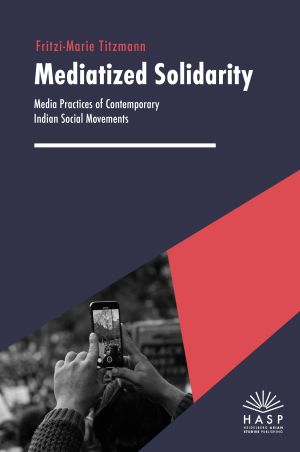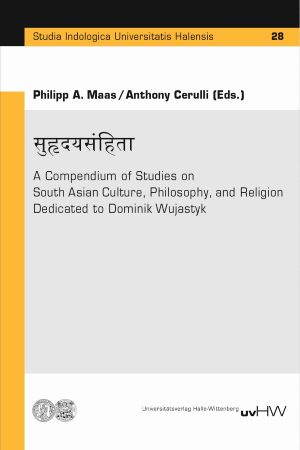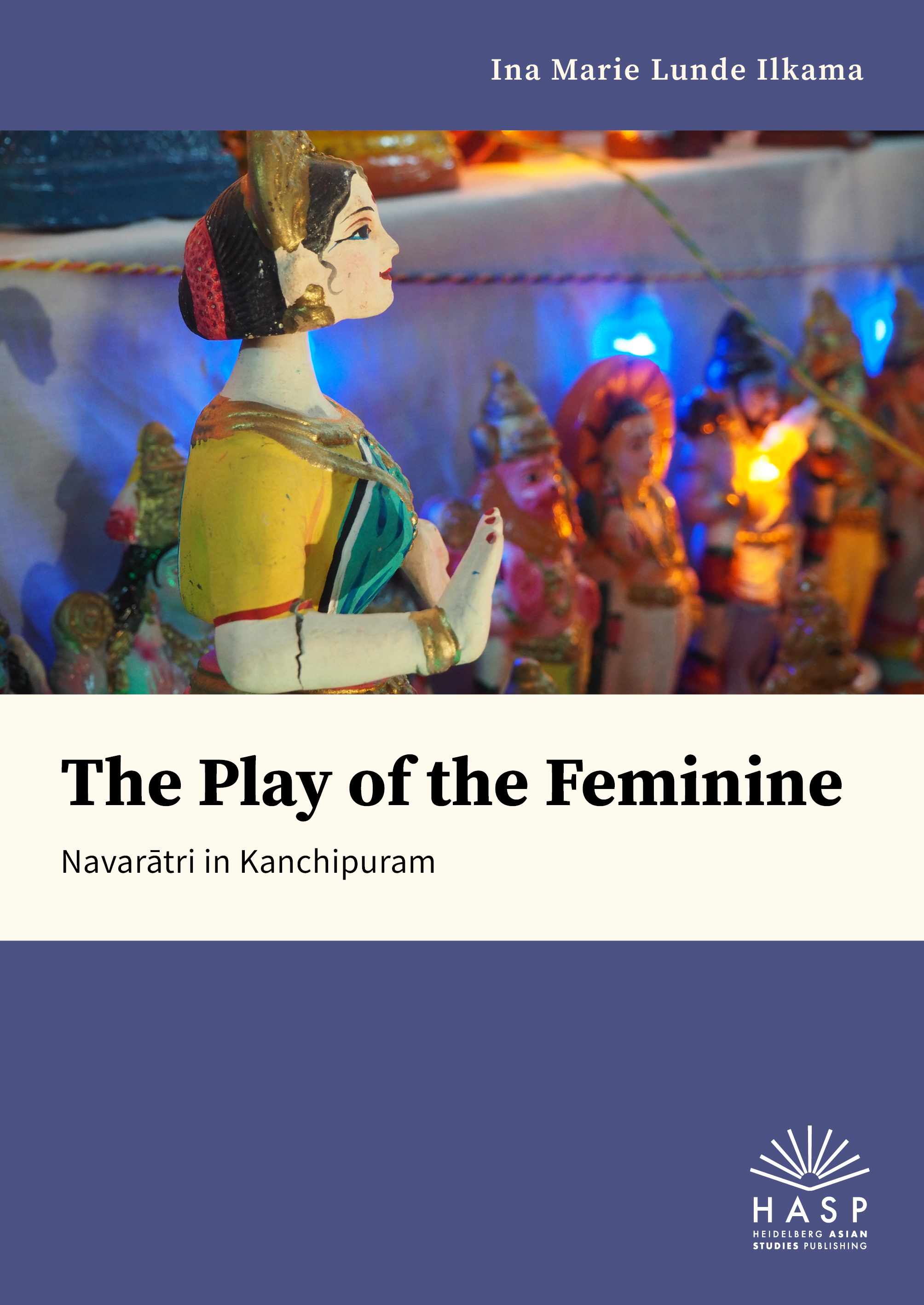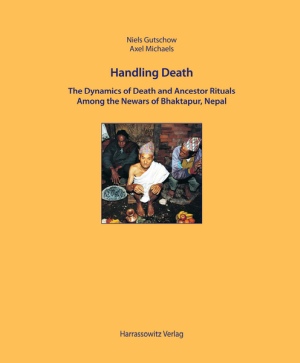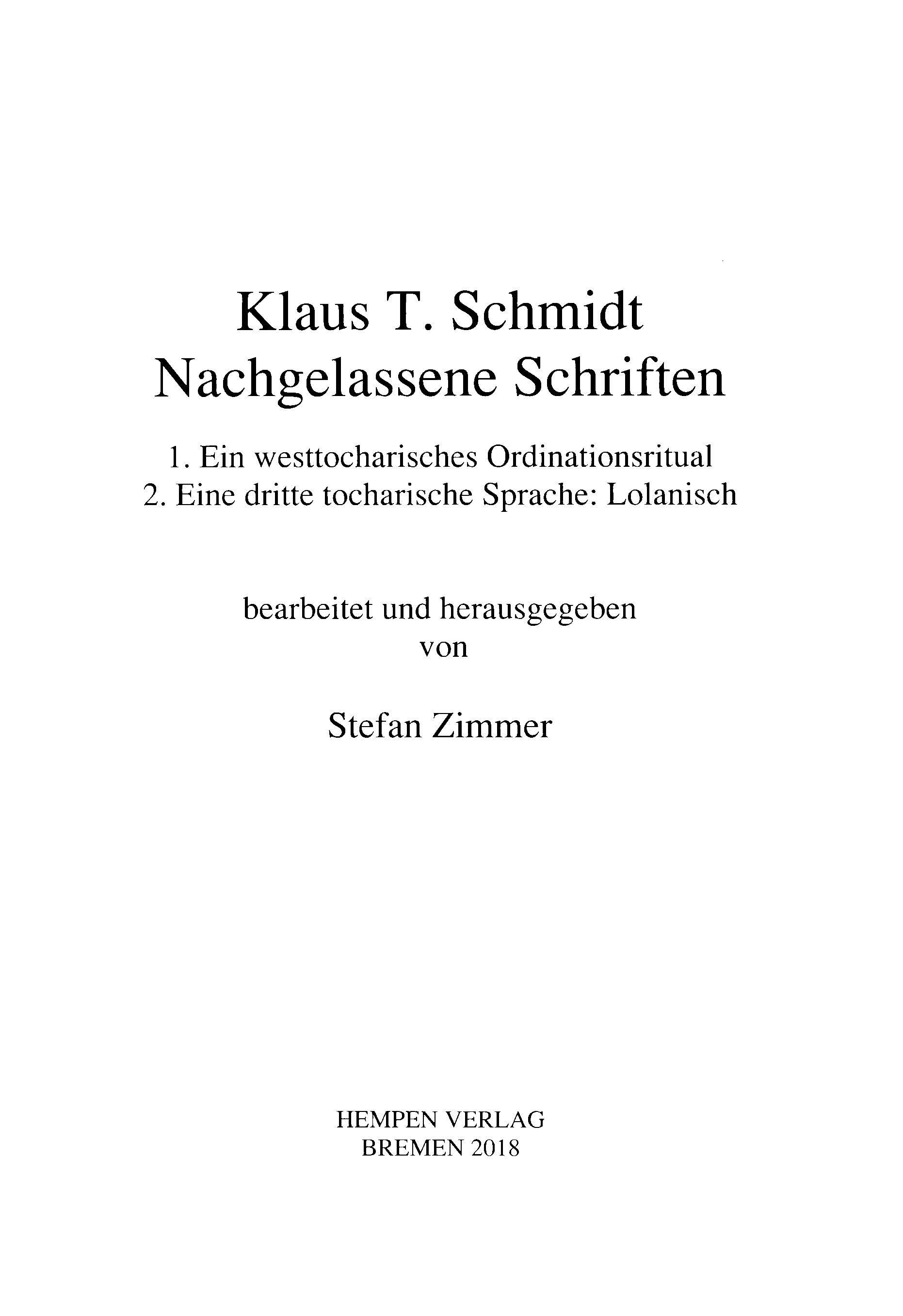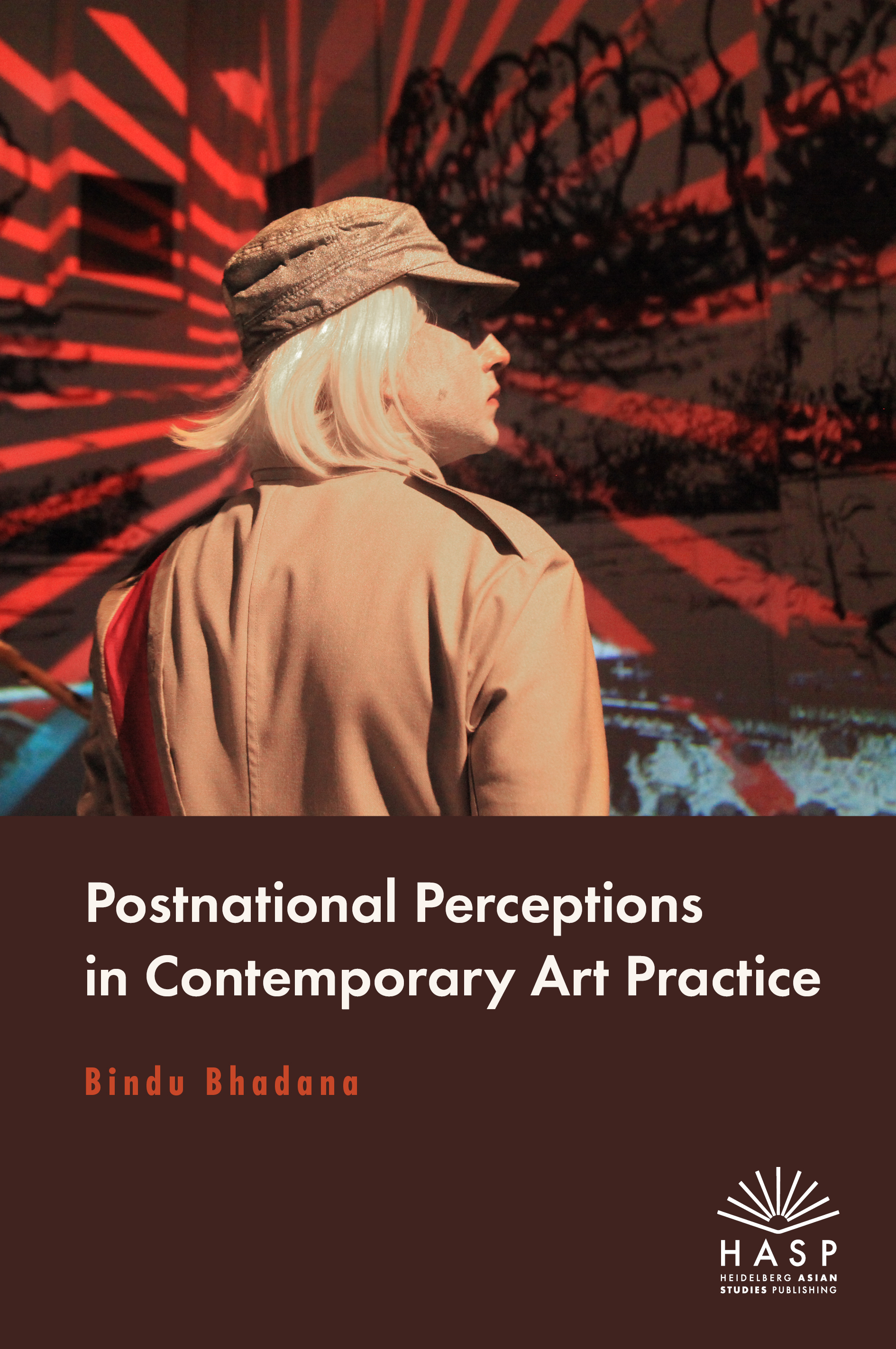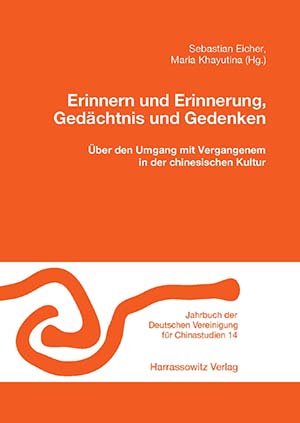##plugins.themes.ubOmpTheme01.catalogue.books##
Raum und Grenze in den Chinastudien
Die im November 2013 an der Julius-Maximilians-Universität Würzburg durchgeführte XXIV. Jahrestagung der Deutschen Vereinigung für Chinastudien widmete sich dem Thema „Raum und Grenze“. Sie lud zur Auslotung des Erkenntnispotenzials einer Hinwendung zum Raum, eines spatial turn in der chinabezogenen Forschung ein. Neben Beiträgen mit dem eher konventionellen Ansatz von Raum und Grenze als Territorialität wurden auch Untersuchungen zu Raum als sozialer Konstruktion vorgestellt, wobei Praktiken der Raumkonstitution, -erschließung und -beherrschung sowie Akte der Ein- und Ausgrenzung eine wichtige Rolle spielten.
Mediatised Solidarity: Media Practices of Contemporary Indian Social Movements
In an era marked by rapid media diffusion and globalised social movements, Mediatised Solidarity delves into the evolving dimensions of solidarity within Indian social and protest movements. Focused on the period from 2014 to the present, it analyses the interplay between media practices, including social media, and solidarity expressions. Through three case studies – Shaheen Bagh, the Indian Farmers’ Protest, and contemporary youth climate activism – the book explores how media and visual art shape and are shaped by solidarity and the extent to which shared memories and cultural heritage are used to stage social cohesion.
The Goddess’s Embrace: Multifaceted Relations at the Ekāmranātha Temple Festival in Kanchipuram
The study by Kerstin Schier examines the big annual festival (mahotsava) at the Ekāmranātha temple in the South Indian town Kanchipuram, which – among other things – dramatises the divine marriage between god Śiva (as Ekāmranātha) and the goddess, generally considered to be Kāmākṣī.
In the course of the festival’s rituals gods and goddesses, temples, and religious traditions relate to each other in many ways. These complex and multifaceted relations are studied by taking into account different types of historical and contemporary sources, and by combining textual analysis with the observation and study of ritual performances, interviews, and oral narratives.
The book provides a detailed description and analysis of the divine marriage’s contemporary ritual practice and its associated myth in Sanskrit and Tamil texts. It also takes into consideration the different views and interpretations of members of local communities, temple priests, donors, and other participants, which leads to a multiplicity of perspectives on the festival.
Leisurely Feelings: Emotions and Concepts of Otium in South Asia
This book traces a conceptual history of literature, leisure and emotions in modern South Asia. Reading colonial capitalism as entwined with the ‘myth of the lazy native’, it focuses on vernacular literary contestations in Urdu and Bengali. It foregrounds otium, leisure and idleness as entangled with emotions and temporalities. The book approaches literary spheres through the lenses of emotions, the self, and the community. Literary discourses of otium are analysed in stylistic innovations, negotiations of colonial modernity and postcolonial uncertainties. Highlighting key literary-conceptual expressions, discussions, and processes, the author explores nostalgia, melancholy, topophilia and haunting as emotions deeply attached to South Asian literary cultures while also resonating with concepts of otium across global modernity.
Vom Feueraltar zum Yoga: Kommentierte Übersetzung und Kohärenzanalyse der Kaṭha-Upaniṣad
Die Kaṭha-Upaniṣad ist ein vor etwa 2000 Jahren verfasster Sanskrit-Text, der sich mit dem Wesen des Menschen nach dem Tod beschäftigt. Als eine der frühesten Quellen, die eine als Yoga bezeichnete heilseffektive Methode lehren, hat sie auch außerhalb Südasiens Bekanntheit erlangt. Aufgrund ihrer textlichen Heterogenität wurde ihr jedoch schon oft Inkohärenz unterstellt.
In der vorliegenden Studie legt Dominik A. Haas eine neue, kommentierte Übersetzung der Kaṭha-Upaniṣad vor und analysiert sie mit Hilfe textlinguistischer Methoden. Er argumentiert, dass diese Upaniṣad von Anfang an als Kompilation konzipiert war, die neue kontemplative und yogische Lehren mit der Ritualmystik des berühmten vedischen Feueraltars verbinden sollte.
New Silk Road Narratives: Local Perspectives on Chinese Presence along the Belt and Road Initiative
It is not only goods, financial capital or technologies that are being traded, negotiated and circulated along the China-led Belt and Road Initiative but also values, emotions and cultural practices. The latter are often decisive when imagining and establishing a transregional infrastructure of the scale of the BRI. This book explores connections and disconnections along the New Silk Roads through narratives and their cultural configurations. Focusing on China-Africa-relations, the authors of this book investigate the role of narratives and various forms of cultural configurations to understand how processes of transregionalization shape local patterns of thought, perception and practice.
Aktuelle Forschungsbeiträge zu Südasien: 13. Jahrestagung des AK Südasien, 03.-04.02.2023, Eberswalde
Extended Abstracts der 13. Jahrestagung des AK Südasien, 03.-04.02.2023, Eberswalde
Transgression in the Bengali Avant-garde: The Poetry of the Hungry Generation
Transgression in the Bengali Avant-Garde wants to introduce the Hungry Generation movement to a global audience through its poetry, manifestoes and other literary materials. Emerged from the cities of Patna and Calcutta in the early 1960s, the Hungry Generation gained international attention after the poets' arrest on charges of obscenity in 1964. Fiercely provoking the literary establishment, these Bengali bohemians used poetry and literature as means of cultural radicalism, tackling subjects like sexuality, perversion, alcohol and drug consumption, masturbation, and hyper-masculinity to challenge bourgeois morality and respectability.
The book sheds light on a variety of Hungryalist sources and explores the literature of the Hungry Generation through the filter of 'transgression', showing how this concept unfolded in the language, aesthetics and culture behind this Bengali avant-garde movement. Furthermore, the book will delve into the poetry of some iconic representatives of the Hungry Generation, critically reading their oeuvre in the context of changing models of sexuality, consumption, and modernization in post-colonial India.
Veda-Sätze – Vedic Sentences
In den altindischen Veden findet man Sätze mit sehr verschiedenen Inhalten, darunter religiöse Aussagen ("Varuṇa ist wahrhaftig der Götter König"), Lebensweisheiten ("Das Denken ist schneller als die Rede") oder auch banale Beobachtungen ("Gattin und Gatte waschen einander den Rücken"). Die bekannten Erlanger Indogermanisten und Indologen Karl Hoffmann (1915-1996) und Johanna Narten (1930-2019) haben bei ihrer jahrzehntelangen Arbeit an den Veda-Texten solche Sätze in der Originalsprache gesammelt. Diese Sammlung von 863 Kurztexten wurde von Antonia Ruppel und Bernhard Forssman zweisprachig (Englisch und Deutsch) mit Übersetzungen und einem vollständigen Vokabular versehen und wird hier erstmals veröffentlicht.
The ancient Indian Vedas contain sentences of rather varied content, including religious statements ("Varuṇa truly is the king of the gods"), words of wisdom ("Thought is quicker than speech") or even banal observations ("Wife and husband wash each other's back"). The well-known Erlangen Indo-Europeanists and Indologists Karl Hoffmann (1915-1996) and Johanna Narten (1930-2019) collected such sentences in the original language during their decades of work on the Vedas. Antonia Ruppel and Bernhard Forssman have furnished this collection of 863 short texts with translations and a complete vocabulary in two languages (English and German) and are publishing it here for the first time.
Reimagining Housing, Rethinking the Role of Architects in India
This book explores the self-perception of critical architects in post-independent and contemporary India. It takes particular interest in the role of documentary films and other media forms used by architects to intervene in debates on affordable housing and to share their alternative visions on spatial design and sustainable architecture. As a heterogeneous and highly mobile group of social actors, architects and designers develop and implement viable solutions at the intersection of extremely complex challenges and specific local contexts. The book argues that the interconnections in their design thinking and work can best be understood through the conceptual lens of critical regionalism.
Suhṛdayasaṃhitā: A Compendium of Studies on South Asian Culture, Philosophy, and Religion. Dedicated to Dominik Wujastyk
The Suhṛdayasaṃhitā is an edited volume dedicated to Dominik Wujastyk that brings together thirteen studies on South Asian intellectual and cultural history from the beginning of the common era to the present day. The multi-disciplinarity and vitality of the academic fields of Indology and South Asian Studies are on full display from chapter to chapter, as leading scholars ask new questions and propose new methods to explore critical topics in their respective fields, including the relationship of the Gāndhāri and Sanskrit languages, bird divination in Indian and cross-cultural contexts, the world view and ethics of early Ayurveda, line drawings in alchemical Sanskrit manuscripts, cannabis in traditional alchemy (Rasaśāstra), deontic logic and terminological problems in Mīmāṃsā and Dharmaśāstra, the identification of an obscure Yoga work referenced in the commentarial literature of the Mahābhārata, psychological transformation and spiritual liberation in Pātañjala Yoga and Buddhism, Sanskrit editorial techniques and the history of printing, the human genome project and the Mahābhārata’s text genealogy, and, finally, the academic pedagogy of contemporary medical anthropology. The time-tested method of analyzing primary sources in Sanskrit and Middle-Indo-Arian languages within their culture-specific historical contexts is fertilized by neuroscience, psychology, evolutionary biology, and anthropology.
In its thematic and methodological diversity, the festschrift, which concludes with a list of Dominik Wujastyk’s works and three indexes, mirrors the broad range of academic interests and expertise of the scholar it is dedicated to.
Getting Married: Hindu and Buddhist Marriage Rituals Among the Newars of Bhaktapur and Patan, Nepal
With contributions by Manik Bajracharya, Christiane Brosius, and Tessa Pariyar
Getting Married is the third and final volume on Hindu and Buddhist life-cycle rituals among the Newars of the ancient city of Bhaktapur in Nepal. It combines extensive fieldwork and the edition and translation of relevant ritual handbooks. While Handling Death, the first volume, focussed on the dynamics of death and ancestor rituals, and Growing Up, the second volume, focussed on the rituals of childhood, adolescence and youth (especially the male and female initiation rituals), the present volume deals with a number of rituals related to marriage.
After an introductory overview of studies on marriage rituals in Nepal the authors give some basic marriage rules of Hindu and Buddhist Newars, the social topography and hierarchy, the families of the marriage partners as well as the problems of endogamy and exogamy in Bhaktapur. They present a detailed description of Hindu and Buddhist marriage rituals among Newars (which are partly documented on the DVD included in this book) and come to relevant conclusions regarding life-cycle rituals in general and the place marriage rituals occupy in Newar society and Hinduism. Furthermore the texts used by Brahmin and Buddhist priests during these rituals are edited and translated and complemented by comprehensive Appendices including a list of elements of Newar rituals and mantras as well as a mantra and general index to all three volumes. The richly illustrated books have been highly appreciated by the scholarly community as a unique attempt to provide a comprehensive ethno-indological study of all major life-cycle rituals of a certain Hindu and Buddhist community.
The film, which was originally published on a DVD accompanying the book, is archived in the heidICON multimedia database and can be viewed via the following link:
Getting Married
Growing Up: Hindu and Buddhist Initiation Rituals among Newar Children in Bhaktapur, Nepal
The authors – an architectural historian (Niels Gutschow) and an indologist (Axel Michaels) – are presenting the second part of a trilogy of studies of life-cycle rituals in Nepal, carried out under the auspices of the Collaborative Research Centre “Dynamics of Ritual”. The initiation of boys and girls of both Hindus and Buddhists of the ethnic community of Newars in the Kathmandu Valley are documented. The first part of the book presents elements of Newar rituals, the spatial background of Bhaktapur and the hierarchy of ritual specialists – illustrated by 21 maps. The second part documents with detailed descriptions the. rst feeding of solid food, birthday rituals, and pre-puberty rituals like the first shaving of the hair, the boy’s initiation with the loincloth (in Buddhist and Hindu contexts), the girl’s marriage with the bel fruit and the girl’s seclusion. One girl’s marriage (Ihi) and three boy’s initiations (Kaytapuja) are documented on a DVD. The third part presents the textual tradition: local handbooks and manuals used by the Brahmin priest to guide the rituals. Two of these texts are edited and translated to demonstrate the function of such texts in a variety of contexts.
The films, which were originally published on a DVD accompanying the book, are archived in the heidICON multimedia database and can be viewed via the following links:
1. Bel fruit and loincloth - initiations of boys and girls in Bhaktapur, Nepal
2. Bel-Frucht und Lendentuch - Initiationen von Mädchen und Jungen in Bhaktapur, Nepal
Jaina Temple Architecture in India: The Development of a Distinct Language in Space and Ritual
Jaina Temple Architecture in India is the first comprehensive study of the development and uniqueness of Jaina sacred structures. The monograph analyses temples in the whole of India and outlines clear continuities by covering the period from the early centuries BCE till the present day. It identifies a distinct Jaina approach to the shaping of ritual space, which involves often complex spatial layouts on various superimposed vertical levels as well as conglomerates of interconnected sanctums and building elements on the horizontal plane. These accommodate a multitude of venerated objects and mirror specific Jaina patterns of worship as well as Jaina mythological and cosmological concepts.
Creating Slogans for Social Change: An Inquiry into Advertising, Gender Imagery, and the Politics of Change in Urban India
What role media content plays in processes of change is an ongoing and multi-layered discussion. Therein, advertising and gender have an extraordinary position. In the context of advertising production in urban India, this book deals with the understanding of social change in the early 2010s. Through an inquiry of the production of advertising created for commercial and/or social purposes, the perceptions of advertising producers are highlighted. The analysis presents the realities of the producers as well as debates surrounding the creation processes. Thereby, the complexities and intertwining of advertising are uncovered, while dynamics of gender, media, and change are discussed.
The Play of the Feminine: Navarātri in Kanchipuram
In Tamil Nadu, the nine-night autumnal Navarātri festival can be viewed as a celebration of feminine powers in association with the goddess. This book explores Navarātri as it is celebrated in the South Indian temple town of Kanchipuram. It investigates the local mythologies of the goddess, two temple celebrations, and the domestic ritual practice known as kolu (doll displays). The author highlights three intersecting themes: namely the play of the goddess in myth and ritual, the religious agency and images of women and the divine feminine, and notions of playfulness in Navarātri rituals; as articulated in creativity, aesthetics, competition, and dramatic expressions.
Sanskrit as an Indo-European Language
Students of Sanskrit can choose among several good textbooks. Whichever they may choose, learning Sanskrit is a daunting task. This book is not an alternative textbook for learning Sanskrit. Instead, it is to accompany these textbooks and written in the hope to make Sanskrit learning easier by explaining words and grammatical forms from an Indo-European point of view. Consider, for example Old Indian ad which means “to eat”, but is also historically related to both English (abbreviated by E) eat and New High German (NHG) essen. There was an Indo-European (IE) root ed that branched out into all these words over some millennia. Even E tooth and NHG Zahn stem from IE ed.
Handling Death: The Dynamics of Death and Ancestor Rituals Among the Newars of Bhaktapur, Nepal
In a rare combination of competence, an architectural historian (Niels Gutschow) and an indologist (Axel Michaels) have documented death rituals of the ethnic community of Newars in the Kathmandu Valley, Nepal. The first part of the book focusses to a specific setting, the ancient city of Bhaktapur and its calendric rituals of death and renewal. An introduction to the urban fabric with its cremation places, routes of death processions, places of spirits and ancestor deities is followed by a presentation of specialists involved in the death and ancestor rituals – illustrated by 28 maps. The second part presents a detailed description of the union of the deceased with his forefathers, a ritual which is also documented on a DVD. In addition, local handbooks and manuals used by the Brahmin priest during this ritual are edited and translated. This ethno-indological method of combination of textual and contextual approaches aims at understanding both the agency in rituals and the function of the text in contexts. Formalized rituals turn out to be by no means strict, stereotypical and unchangeable. The uniqueness of the actors, places and time has prompted the authors to name places and actors and to date time. The study of death rituals represents the first part of a trilogy of studies of life-cycle rituals in Nepal, carried out under the auspices of the Collaborative Research Centre “Dynamics of Ritual” (Sonderforschungsbereich 619: Ritualdynamik).
The ritual was documented by Christian Bau with a video camera and is included as a film on the DVD.
The films, which were originally published on a DVD accompanying the book, are archived in the heidICON multimedia database and can be viewed via the following links:
- Handling death – Latyā – a death ritual of the Newars in Bhaktapur, Nepal
- Den Tod in die Hand nehmen – Latyā - ein Totenritual der Newars in Bhaktapur, Nepal
Exchange, gifting, and sacrificing: Premodern Indian perspectives
In both the Vedic and the classical periods, a special elite class of people existed that were called Brahmins. In a rough manner, one might say that their material wellbeing depended on dakṣiṇā in the Vedic period and on dāna in the classical one.
Broadening the perspective beyond dakṣiṇā and dāna, this book is on all sorts of giving in the context of pre-modern India, using Vedic, Sanskrit, Buddhist and, to a much lesser extent, Roman and Christian sources. The Brahmanical theory of the gift (i.e., the theory of dutiful gifting, dharmadāna) is a major focus of, and has provided a major motivation for, this study.
On the Plastic Surgery of the Ears and Nose: The Nepalese Recension of the Suśrutasaṃhitā
A thousand-year-old Ayurvedic manuscript containing the Compendium of Suśruta was announced to the scholarly world in 2007. The Nepalese manuscript, since adopted by UNESCO as part of the Memory of the World, reveals the state of classical Indian medicine in the ninth century. It enables us to study the changes in this medical classic that have taken place from the ninth to the nineteenth century, when printed texts began to dominate the dissemination of the work. The present monograph describes the research project focussed on this manuscript and offers an edition, study and translation of the historically important chapter about the plastic surgery on the nose and ears.
Mallī-Jñāta: Das achte Kapitel des Nāyādhammakahāo im sechsten Aṅga des Śvetāmbara Jainakanons, herausgegeben, übersetzt und erläutert.
Das achte Kapitel des Nāyādhammakahāo im sechsten Aṅga des Śvetāmbara Jainakanons, herausgegeben, übersetzt und erläutert von Gustav Roth.
Aufbau und Umstrukturierung des Mahāparinirvāṇasūtra: Untersuchungen zum Mahāparinirvāṇa-mahāsūtra unter Berücksichtigung der Sanskrit-Fragmente
Die Geschichte über den Tod des Buddha ist uns in verschiedenen Texten überliefert. Eine Version, das Mahāparinirvāṇa-mahāsūtra, ist einschlägig bekannt als einer der älteren Texte, die die sogenannte “Buddha-Natur-Theorie” vertreten, wonach alle Lebewesen die Natur Buddhas besitzen. Das Sūtra hat über die chinesischen Übersetzungen einen großen Einfluss auf den ostasiatischen Buddhismus ausgeübt. Jedoch ist das Sanskrit-Original nur in Fragmenten überliefert. Die Untersuchungen der Sanskrit-Fragmente beleuchten die Ursprünge dieser Theorie in Indien.
Nachgelassene Schriften: 1. Ein westtocharisches Ordinationsritual, 2. Eine dritte tocharische Sprache: Lolanisch
Der 2017 verstorbene Indogermanist und Tocharologe Klaus T. Schmidt hat zwei Buchmanuskripte hinterlassen: Seine Ausgabe des längsten westtocharischen Textes, eines Ordinationsrituals für buddhistische Mönche, sowie eine unvollendete Arbeit über die seit langem vermutete, aber bisher nicht nachgewiesene dritte tocharische Sprache, von Schmidt "Lolanisch" genannt. Zimmer hat beide Manuskripte vorsichtig redigiert und das zweite mit Abbildungen der von Schmidt bearbeiteten Textfragmente ergänzt. Schmidts Entzifferung des Lolanischen ist ein Meilenstein der Zentralasien-Forschung!
Dhārī Devī, Goddess of the Floods: Development, Disaster and the Transitions of a Place of Worship
The trajectory of the Dhārī Devī Temple epitomises the idea of catastrophes as watersheds. In particular, flood disasters have accompanied transformation processes of the site located on Alaknanda River in the Indian Himalayas. As early as 1894, a flash flood had a significant impact on the site and the identity of the deity. Local flood legends gained new topicality with the planning of a hydroelectric power plant in the vicinity. They became part of debates surrounding the construction scheme that required the relocation of the sacred site. This case study explores flood discourses and illuminates their influence on a development project. It further demonstrates how previous controversies framed the public interpretation of two flood disasters in 2012 and specifically of the "Himalayan Tsunami" in 2013.
God, Jesus and the Ancestors: An Ethnography of the Ancestors’ Rites in the Taiwanese Catholic Church
In this book the author describes the Ancestors Ceremonies as practiced in the Taiwanese Catholic Church. The author’s point is to demonstrate how the Chinese symbolic universe made a deep translation of the "new" symbolic system represented by the Catholic doctrine. At the same time the effort of the Catholic Church in order to adapt the Gospel message to the local situation built up a particular phenomenon that the author defined as cultural dialogue. It is this dialogic relationship the process that the author defines as Culture.
bāteṁ. Hindi-Grammatik kommunikativ 2: Übungen
Der Kopenhagener Hindikurs führt in 46 Lektionen kontextualisiert in die Strukturen des Hindi ein, was einen kommunikativen Grammatikunterricht ermöglicht. Der zweite Teil (L 24-46) gilt dem Verbalsystem in seiner Gesamtheit und der komplexen Syntax – also dem, was im Deutschen die Nebensatzsyntax ausmacht. Die Kontexte entstammen dem Leben der Autoren und ihrer Mitmenschen und laden Lehrer und Lerner dazu ein, sich auf Hindi auszutauschen. Die den Übungen zugrundeliegenden Texte bieten dabei keine abgeschlossene Sicht auf die hindisprachige Welt. Sie leiten vielmehr dazu an, selbst Blickwinkel zu eröffnen und sich dadurch in dialektischer Offenheit das Hindi anzueignen.
Zu jeder grammatischen Struktur gibt es eine Lektion mit einer Auswahl verschiedener Übungsformate, was das Lehrwerk breit einsetzbar macht. Die Lektionen entsprechen etwa den folgenden Stufen des Referenzrahmens des Europarates: L 24-39 = B1.1, L 40-46 = B1.2
bāteṁ. Hindi-Grammatik kommunikativ 1: Übungen
Der Kopenhagener Hindikurs führt in 46 Lektionen kontextualisiert in die Strukturen des Hindi ein, was einen kommunikativen Grammatikunterricht ermöglicht. Im ersten Teil (L 1-23) liegt der Schwerpunkt auf dem Nominalsystem, grundlegenden Verbalkonstruktionen sowie der Syntax des einfachen Satzes. Die Kontexte entstammen dem Leben der Autoren und ihrer Mitmenschen und laden Lehrer und Lerner dazu ein, sich auf Hindi auszutauschen. Die den Übungen zugrundeliegenden Texte bieten dabei keine abgeschlossene Sicht auf die hindisprachige Welt. Sie leiten vielmehr dazu an, selbst Blickwinkel zu eröffnen und sich dadurch in dialektischer Offenheit das Hindi anzueignen.
Zu jeder grammatischen Struktur gibt es eine Lektion mit einer Auswahl verschiedener Übungsformate, was das Lehrwerk breit einsetzbar macht. Die Lektionen entsprechen etwa den folgenden Stufen des Referenzrahmens des Europarates: L 1-12 = A1, L 13-23 = A2
Significant Others, Significant Encounters: Essays on South Asian History and Literature
This volume is dedicated to Maya Burger, professor emerita at the Faculty of Arts, University of Lausanne. It gathers contributions by friends, colleagues, and former students that echo the multiple dimensions of her work. Organised in four parts, Indology, History of Religions, History of Orientalism, and Hindi and Translation, these contributions explore different examples of encounters with “significant others”. Analysing original historical and literary sources and reflecting on the methodological dimensions, the authors offer innovative perspectives on various processes of interaction and exchange between the Indian subcontinent and the wider world and within the subcontinent itself.
Words and Deeds: Hindu and Buddhist Rituals in South Asia
Words and Deeds is a collection of articles on rituals in South Asia with a special focus on their texts and context. The volume presupposes that a comprehensive definition of “ritual” does not exist. Instead, the papers in it avoid essentialist definitions, allowing for a possible polythetic definition of the concept to emerge. Papers in this volume include those on Initiation, Pre-Natal Rites, Religious Processions, Royal Consecration, Rituals which mark the commencement of ritual, Rituals of devotion and Vedic sacrifice as well as contributions which address the broader theoretical issues of engaging in the study of ritual texts and ritual practice, both from the etic and the emic perspective. These studies show that any study of the relationship between the text and the context of rituals must also allow for the possibility that different categories of performers can and do subjectively constitute the relationship between their ritual knowledge and ritual practice, between text and context in differing and nuanced ways.
Computerlinguistische Datierung schriftsprachlicher chinesischer Texte
Die chronologische Einordnung von Texten kann für Authentizitätsforschung und Exegese entscheidend sein. Die Datierung schriftsprachlicher chinesischer Quellen kann u. a. durch Imitation antiker Vorbilder und unklare Urheberschaft erschwert werden. Dieses Buch untersucht erstmals die Entwicklung und Anwendung computergestützter Methoden für die Datierung chinesischsprachiger Quellen. Dabei ermöglicht eine lexembasierte Methode, der stilistischen Rigidität der Schriftsprache zu begegnen und unterstützt damit die philologische Arbeit. Zudem werden der Sprachwandel, die Eignung digitaler Methoden für die Untersuchung Klassischer Texte und das Hanyu da cidian 漢語大詞典 als wichtige Datenquelle für lexikographische Datierung untersucht.
Diese Monografie wurde 2023 mit dem Förderpreis für herausragende Dissertationen des Freundeskreises der Universität Trier ausgezeichnet.
Postnational Perceptions in Contemporary Art Practice
This publication focuses on the works of Chitra Ganesh (b.1974), Tejal Shah (b.1979) and Nikhil Chopra (b.1976) in order to highlight the changing relationship of the gendered body with national identity in contemporary art practice. Ideas of national belonging are challenged precisely through a concerted focus on identities marginalized by the nation. It proposes the ‘postnational’ as an empowering term to mark the shift away from the nation, and, employing a post-structural framework, it argues that the nature of national identity is in itself a construct.
A Flying Dragon: King Taejo, Founder of Korea’s Choson Dynasty
Yi Seong-gye (1335-1408) began life as an obscure warrior of Korea’s borderlands, but rose to overthrow the 500-year Goryeo dynasty and become King Taejo, who founded the 518-year Joseon dynasty, Korea’s final royal lineage and the longest lasting Confucian dynasty in history. King Taejo’s momentous life intersected with watershed East Asian developments: the collapse of the Mongol Empire in Korea, the rise of China’s brilliant Ming dynasty, the pacification of massive Japanese pirating operations, and the rise of Asia’s most thoroughly realized Confucian society in Joseon. This biography tells the tale, ending with the tragic descent of King Taejo‘s own family into fratricide and grief.
Viṣṇu's Children: Prenatal life-cycle rituals in South India
The Vaikhānasas, a group of Brahmanic priests in the Viṣṇu temples of south India, can look back on a long and turbulent history, that is characterized by the effort of claiming their status against rivalling priests. Central to this monograph is a controversy, ongoing for centuries, as to what makes a person eligible to perform the rituals in Viṣṇu temples: does birth or an initiation create the ideal intermediary between the god and humans? Since the 14th century CE the discussions in the relevant Sanskrit texs centre around the question of whether the Vaikhānasas priests must undergo an initiation including a branding on the upper arms, or whether their particular prenatal life-cycle ritual viṣṇubali makes them eligible to perform temple ritual. As hereditary temple priests the Vaikhānasas’ own stance is explicit: they are Viṣṇu’s own children, preordained for temple service already before birth. In addition to the textual perspective, three instances of local conflicts from the 19th/20th centuries about the question of whether the Vaikhānasas require an initiation are analysed in their contexts. Furthermore, three examples of present-day performances of the viṣṇubali ritual are presented and interpreted in the light of the relation between text and performance.
The films, which were originally published on a DVD accompanying the book, are archived in the heidICON multimedia database and can be viewed via the following links:
- Introduction (length 08:10 min)
- Full ritual (length 28:28 min)
- Prepatory rites - Formal declaration (03:51 min)
- Prepatory rites - Vitalisation of the sacrificial fire (06:45)
- Main offerings - Pūjā for Viṣṇu's twelve forms (11:09 min)
- Main offerings - Offering into the fire (09:01 min)
- Main offerings - Viṣṇu marks the unborn child (09:53 min)
- Atonement for ritual flaws (03:46 min)
- Concluding rites (04:43)
- Credits
Of Death and Birth: Icakkiyammaṉ, a Tamil Goddess, in Ritual and Story
Scholars of popular Hindu religion in India have always been fascinated by oral texts and rituals, but surprisingly only few attempts have as yet been made to analyse the relationship between rituals and texts systematically. This book contributes to the filling of this gap. Focusing on the dynamics of a local (non-Brahmanical) ritual, its modular organisation and inner logic, the interaction between narrative text and ritual, and the significance of the local versus translocal nature of the text in the ritual context, the study provides a broad range of issues for comparison. It demonstrates that examining texts in their context helps to understand better the complexity of religious traditions and the way in which ritual and text are programmatically employed. The author offers a vivid description of a hitherto unnoticed ritual system, along with the first translation of a text called the Icakkiyamman-Katai (IK). Composed in the Tamil language, the IK represents a substantially longer and embellished form of a core version which probably goes as far back as the seventh century C.E. Unlike the classical source, this text has been incorporated into a living tradition, and is being constantly refashioned. A range of text versions have been encapsulated in the form of a conspectus, which will shed light on the text’s variability or fixity and will add to our knowledge of bardic creativity.
The films, which were originally published on a DVD accompanying the book, are archived in the heidICON multimedia database and can be viewed via the following links:
Of Death and Birth: A Ritual of the Vēḷāḷas in Paḻavūr, India
- Original recording with voice-over in English.
- Original recording in Tamil without voice-over.
- Stories. The „Stories“ option comprises summaries of both texts sung in the ritual: The translocal story Icakkiyammaṉ Katai and The local Icakki story.
Aktuelle Forschungsbeiträge zu Südasien: 12. Jahrestagung des AK Südasien, 21./22. Januar 2022, Bonn/online
Extendet Abstracts der 12. Jahrestagung des AK Südasien, 21./22. Januar 2022, Bonn/online
In the Shrine of the Heart: Sants of Rajasthan from the Sixteenth and Seventeenth Centuries
In the early modern period, the Sants emerged in North India as devotees of a formless interior god. The volume introduces seven Sant authors living in Rajasthan in the period from the first half of the sixteenth to the eighties of the seventeenth century. It explores their complex cultural background, their literary conventions, and their sectarian network, and presents samples of their poetry in the original Hindi with English translations. By far the most of the compositions in this volume have not been translated before, and of one of these the original text is published also for the first time.
Sant poetry has been transmitted in oral and written form. It owes its continuing vitality largely to congregational and private performance. This fact has been illustrated by a number of audio and video samples.
China, Kropotkin und der Anarchismus: Eine Kulturbewegung im China des frühen 20. Jahrhunderts unter dem Einfluß des Westens und japanischer Vorbilder
Ziel dieses Buches ist es, einen umfassenden Überblick über die Rolle des Anarchismus im China des frühen 20. Jahrhunderts zu geben. Bislang hat sich die Wissenschaft eher auf die politischen Aspekte wie die Rivalität zwischen den Anarchisten und der KPCh konzentriert und den Anarchismus lediglich als Teil der neueren chinesischen Geschichte behandelt. Diese Studie nähert sich dem chinesischen Anarchismus aus der Perspektive einer kulturellen und international eingebundenen Bewegung, was eine breite Diskussion verschiedener Aspekte im Zusammenhang mit der Genese und Entwicklung der chinesischen anarchistischen Bewegung im Rahmen des Weltanarchismus impliziert.
Puṣpikā: Proceedings of the 12th International Indology Graduate Research Symposium (Vienna, 2021)
In the series Puṣpikā – Tracing Ancient India through Texts and Traditions: Contributions to Current Research in Indology, the proceedings of the International Indology Graduate Research Symposium (IIGRS) are published. Puṣpikā is a peer-reviewed series that provides early-career scholars with a platform to share the results of their research on pre-modern South Asian cultures.
This is the 6th volume in the series, containing thirteen articles based on the talks presented at the 12th IIGRS online and in Vienna, Austria on 22–24 July 2021.
Kushan Histories: Literary Sources and Selected Papers from a Symposium at Berlin, December 5 to 7, 2013
Kushan Histories discusses new research concerning the Kushan dynasty and is based on a Symposium held from December 5-7th, 2013 in Berlin.
Rechtskultur und Gerechtigkeitssinn in China
Diskurse über Ordnung und Gesetz innerhalb und zwischen Staaten prägen bereits die frühen überlieferten Schriften aus China. Ob in der philosophischen Debatte zwischen Konfuzianismus und Legismus oder in der Diskussion und Auslegung des Strafrechts durch die höfischen Beamtengelehrten – Rechtsverständnis und Gerechtigkeitsempfinden blieben das chinesische Kaiserreich hindurch von zentraler Bedeutung. Das heutige China sorgt für Kontroversen in Hinblick auf Verbrechen, Strafrecht und Ethik, wobei im In- und Ausland insbesondere chinesische Eigenarten und ausländische Einflussnahmen kritisch diskutiert werden. Im aktuellen Gesellschaftsdiskurs Chinas stehen Fragen nach sozialer Gerechtigkeit und Chancengleichheit im Vordergrund, die auch mit der Legitimität der chinesischen Regierung zusammenhängen. Der hiermit skizzierte Themenkomplex Recht und Gerechtigkeit stand im Mittelpunkt der 25. Jahrestagung der Deutschen Vereinigung für Chinastudien (DVCS), die vom 7. bis 9. November 2014 in Münster stattfand. Der dazugehörige Tagungsband vereint Beiträge von elf Autorinnen und Autoren, die sich Recht und Gerechtigkeit in China aus philologischer, philosophischer, literarischer, historischer, soziologischer, politologischer und nicht zuletzt rechtswissenschaftlicher Sicht nähern. Der Band umfasst sowohl methodisch als auch zeitlich die Bandbreite der Chinawissenschaften, indem relevante Fragestellungen von der West-Zhou-Zeit bis in die jüngste Gegenwart analysiert werden. Das Ergebnis ist ein facettenreicher Zwischenstand, der auch eine fundierte Grundlage für künftige Diskussionen liefert.
Aus technischen Gründen können minimale Unterschiede zwischen dieser digitalen Version und der Druckversion von Harrassowitz bestehen.
Erinnern und Erinnerung, Gedächtnis und Gedenken: Über den Umgang mit Vergangenem in der chinesischen Kultur
Teile der Vergangenheit im kollektiven Bewusstsein zu halten und gezielt zu vergegenwärtigen, prägt unmittelbar auch die subjektive Wahrnehmung des Individuums. Geteilte Erinnerungen sind eine wichtige Grundlage der Identitäts- und Gemeinschaftsbildung. Formen des Reproduzierens und der Reproduzierbarkeit des Erinnerns, die das Festhalten von Vergangenem wie das Bewahren gegenwärtiger Erkenntnisse einschließen, sind kulturell und historisch bedingt. So gehören zu jeder Kultur des Erinnerns und Gedenkens – oder auch des Vergessens – gesellschaftliche Auseinandersetzungen, Verkettungen, Krisen und Schicksalsschläge ebenso wie positiv besetzte Momente und glückliche Begebenheiten.
Um die Bedeutung der Erinnerungskultur für die vergangene und gegenwärtige Entwicklung Chinas aufzuzeigen, betrachtet der von Maria Khayutina und Sebastian Eicher herausgegebene Band die chinesische Erinnerungskultur aus historischer, philologischer, literaturwissenschaftlicher und kulturwissenschaftlicher Perspektive und das über einen langen Zeitraum vom frühen Mittelalter bis in die Gegenwart. Die Fallstudien der neun Autorinnen und Autoren widmen sich so unterschiedlichen Quellen wie frühmittelalterlichen geographischen Werken, Dynastiegeschichten, Song-zeitlichen Gedichten, Ming-Romanen sowie Wörterbüchern, immateriellem Kulturerbe auf der UNESCO-Liste und zeitgenössischen Filmen bis hin zu aktuellen Entwicklungen auf dem Feld der künstlichen Intelligenz.
Aus technischen Gründen können minimale Unterschiede zwischen dieser digitalen Version und der Druckversion von Harrassowitz bestehen.
Temples, Texts, and Networks: South Indian Perspectives
For many centuries, Hindu temples and shrines have been of great importance to South Indian religious, social and political life. Aside from being places of worship, they are also pilgrimage destinations, centres of learning, political hotspots, and foci of economic activities. In these temples, not only the human and the divine interact, but they are also meeting places of different members of the communities, be they local or coming from afar. Hindu temples do not exist in isolation, but stand in multiple relationships to other temples and sacred sites. They relate to each other in terms of architecture, ritual, or mythology, or on a conceptual level when particular sites are grouped together. Especially in urban centres, multiple temples representing different religious traditions may coexist within a shared sacred space. The current volume pays close attention to the connections between individual Hindu temples and the affiliated communities, be it within a particular place or on a trans-local level. These connections are described as “temple networks,” a concept which instead of stable hierarchies and structures looks at nodal, multi-centred, and fluid systems, in which the connections in numerous fields of interaction are understood as dynamic processes.
Reviews
Amol Saghar in: IIAS Reviews (2023)
Das Kapīśāvadāna und seine Parallelversion im Piṇḍapātrāvadāna
Die vorliegende Arbeit ist eine überarbeitete Fassung der 1992 von der Philosophischen Fakultät der Rheinischen Friedrich-Wilhelms-Universität Bonn angenommenen Dissertation. Sie beinhaltet die Edition und Übersetzung des Kapīśāvadāna und dessen Parallelversion im Piṇḍapātrāvadāna sowie eine Einleitung mit drei Schwerpunkten:
1. die Zuordnung der verschiedenen Hss der beiden Avadānas zu den entsprechenden Fassungen und, soweit möglich, die Darstellung des Verhältnisses der verschiedenen Fassungen zueinander,
2. die vom Autor benutzten buddhistischen Erzählmotive und
3. die hybriden Sanskrit-Formen.
The Heart of Change - Issues on Variation in Hindi
The present volume, which comprises seven English contributions and four in Hindi, addresses issues of linguistic variation – a phenomenon central to the study of language use – in regard to the major official language of India. It combines multiple theoretical and pragmatic approaches to a variety of linguistic phenomena conceptualised under the designation 'Hindi’ and attempts to obtain a more accurate portrayal of the changing reality behind this versatile taxonomic term. In doing so, this volume provides insight into how the forms and functions of Hindi are changing across borders within and outside of India; the concept of language contact is thus present in several of the studies. The analyses are based upon data observed in written texts, including manuscripts, and elicited from instances of oral speech.
The contributions, prepared by established and emerging scholars from several Asian and European countries, investigate functional aspects of the regional, social, and cultural forms of Hindi and how they interact in differing contexts, time periods, and types of communication. A similar vantage point is being adopted in the investigation of possibilities and constraints of formal variation in the grammatical structures of Standard Hindi. In addition to providing analyses from the perspectives of both general linguistics and sociolinguistics, the book discusses issues associated with teaching Hindi from the perspective of language variation.
The volume is distinguished by its innovative character in terms of both the data utilized in it and the width of its scope, and aims to contribute to a better understanding of ‘Hindi’ as a concept as well as of the general principles of linguistic variation.
Die Lekhapaddhati-Lekhapañcāśikā: Briefe und Urkunden im mittelalterlichen Gujarat
Text, Übersetzung und Kommentar der Lekhapaddhati-Lekhapañcāśikā, ein anonymer, in Jaina- bzw. Gujarātī-Sanskrit verfasster Text aus dem mittelalterlichen Gujarat, der Muster von Urkunden und Briefen enthält.
Sound, Meaning, Shape: The Phonologist Wei Jiangong (1901-1980) between Language Study and Language Planning
One of the leading proponents of the radical linguistic reforms in 20th century China, Wei Jiangong remains hardly known in the West. This book describes how Wei, who was rooted in traditional philology and conceptualizing language as a tool, helped to promulgate a standard language, led the compilation of the world’s most popular dictionary, and helped to drive script reform. While these measures were characterized as violent intervention in the Chinese language sphere, Wei’s careful negotiating of linguistic description and political prescription illustrates how they also may have been steps that helped to achieve linguistic self-determination.
Reviews
Yurou Zhong, in: China Quarterly (2023), 1-2
Aktuelle Forschungsbeiträge zu Südasien: 11. Jahrestagung des AK Südasien, 07./08. Mai 2021, Göttingen/Online
Extended Abstracts der 11. Jahrestagung des AK Südasien, 07./08. Mai 2021 in Göttingen (Online).
Theorising Emotions: An Enquiry into the Emotion Knowledge of Premodern Tamil Treatises
It is impossible to imagine human history without emotions. But what is known about theoretical emotion knowledge in premodern South India? This volume offers a first systematic examination of emotion knowledge as found in Tamil treatises and commentaries written from the 11th to 17th century. By following different theoretical strands, it sheds light on the questions that were raised by various emotion theorists, as well as their agenda and theorising practices. It points out changes, linearity, and disruptions in their ideas, as well as historically marginal knowledge. Perhaps surprisingly, the only systematic works on emotion produced by medieval and early modern Tamil thinkers were on emotion in poetics.
Bruchstücke des Bhikṣuṇī-Prātimokṣa der Sarvastivādins; Bruchstücke buddhistischer Sūtras aus dem zentralasiatischen Sanskritkanon
Faksimile-Reproduktion der ursprünglich 1926 und 1932 bei der Deutsche Morgenländische Gesellschaft in Kommission bei F. A. Brockhaus erschienenen Werke "Bruchstücke des Bhikṣuṇī-Prātimokṣa der Sarvastivādins" und "Bruchstücke buddhistischer Sūtras aus dem zentralasiatischen Sanskritkanon", zusammengefasst in einem Band.
Die Sīmā: Vorschriften zur Regelung der buddhistischen Gemeindegrenze in älteren buddhistischen Texten
Die vorliegende Untersuchung ist die erweiterte Fassung meiner 1989 vom Fachbereich Historisch-Philologische Wissenschaften in Göttingen angenommenen Dissertation. Sie setzt sich aus drei Teilen zusammen, die jeweils in sich abgeschlossen und mit einer separaten Einleitung versehen sind. Der erste Teil dieser Arbeit (A) ist dem Terminus sīmā im Vinaya der Theravādin gewidmet. Dabei werden in einem ersten Abschnitt (I) die im zweiten Kapitel des Mahāvagga überlieferten Vorschriften zur Regelung der Sīmā untersucht, während in einem zweiten Abschnitt (II) die Anwendung des Terminus sīmā in alien übrigen Teilen des Vinaya behandelt wird. Teil A soll somit einen Überblick darüber vermitteln, welche Sīmā-Regelungen in dieser frühen Periode bereits in Kraft waren und wie sie angewendet wurden. Im zweiten Teil (B) wird sodann der Kommentar zu den Sīmā-Regeln im Vinaya, d. h. zu dem in A I behandelten Text, aus Buddhaghosas Samantapāsādikā bearbeitet. Hierbei werden zu einer Reihe von Textstellen auch die drei großen Vinayaṭīkās - Vajirabuddhiṭīkā, Sāratthadīpānī und Vimativinodanīṭīkā - herangezogen. In Teil C werden anhand der aus Gilgit stammenden Sanskrit-Handschrift des Vinayavastvāgama und der im Kanjur überlieferten tibetischen Ubersetzung die im Kapitel uber die buddhistische Beichtfeier iiberlieferten Sīmā-Regeln der Mūlasarvāstivādin untersucht und mit den Regelungen der Theravādin verglichen.




